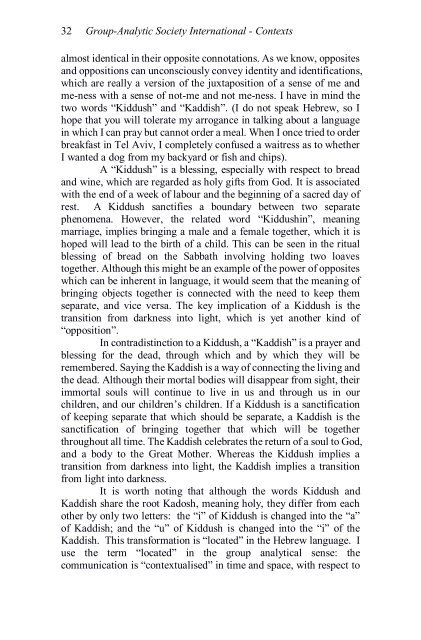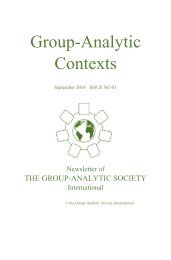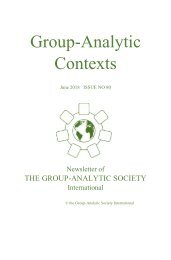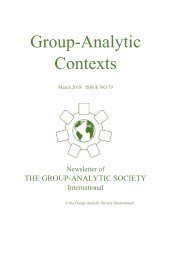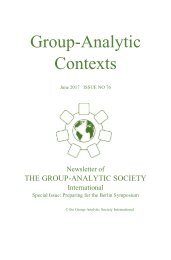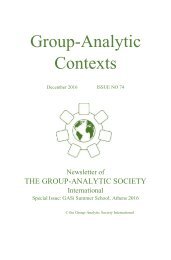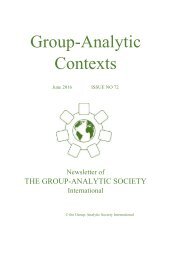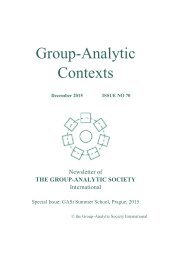Group-Analytic Contexts, Issue 78, December 2017
You also want an ePaper? Increase the reach of your titles
YUMPU automatically turns print PDFs into web optimized ePapers that Google loves.
32 <strong>Group</strong>-<strong>Analytic</strong> Society International - <strong>Contexts</strong><br />
almost identical in their opposite connotations. As we know, opposites<br />
and oppositions can unconsciously convey identity and identifications,<br />
which are really a version of the juxtaposition of a sense of me and<br />
me-ness with a sense of not-me and not me-ness. I have in mind the<br />
two words “Kiddush” and “Kaddish”. (I do not speak Hebrew, so I<br />
hope that you will tolerate my arrogance in talking about a language<br />
in which I can pray but cannot order a meal. When I once tried to order<br />
breakfast in Tel Aviv, I completely confused a waitress as to whether<br />
I wanted a dog from my backyard or fish and chips).<br />
A “Kiddush” is a blessing, especially with respect to bread<br />
and wine, which are regarded as holy gifts from God. It is associated<br />
with the end of a week of labour and the beginning of a sacred day of<br />
rest. A Kiddush sanctifies a boundary between two separate<br />
phenomena. However, the related word “Kiddushin”, meaning<br />
marriage, implies bringing a male and a female together, which it is<br />
hoped will lead to the birth of a child. This can be seen in the ritual<br />
blessing of bread on the Sabbath involving holding two loaves<br />
together. Although this might be an example of the power of opposites<br />
which can be inherent in language, it would seem that the meaning of<br />
bringing objects together is connected with the need to keep them<br />
separate, and vice versa. The key implication of a Kiddush is the<br />
transition from darkness into light, which is yet another kind of<br />
“opposition”.<br />
In contradistinction to a Kiddush, a “Kaddish” is a prayer and<br />
blessing for the dead, through which and by which they will be<br />
remembered. Saying the Kaddish is a way of connecting the living and<br />
the dead. Although their mortal bodies will disappear from sight, their<br />
immortal souls will continue to live in us and through us in our<br />
children, and our children’s children. If a Kiddush is a sanctification<br />
of keeping separate that which should be separate, a Kaddish is the<br />
sanctification of bringing together that which will be together<br />
throughout all time. The Kaddish celebrates the return of a soul to God,<br />
and a body to the Great Mother. Whereas the Kiddush implies a<br />
transition from darkness into light, the Kaddish implies a transition<br />
from light into darkness.<br />
It is worth noting that although the words Kiddush and<br />
Kaddish share the root Kadosh, meaning holy, they differ from each<br />
other by only two letters: the “i” of Kiddush is changed into the “a”<br />
of Kaddish; and the “u” of Kiddush is changed into the “i” of the<br />
Kaddish. This transformation is “located” in the Hebrew language. I<br />
use the term “located” in the group analytical sense: the<br />
communication is “contextualised” in time and space, with respect to


